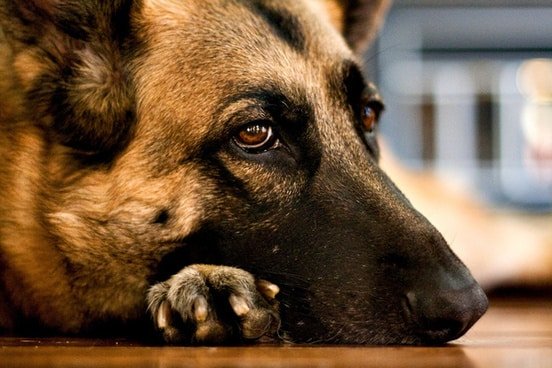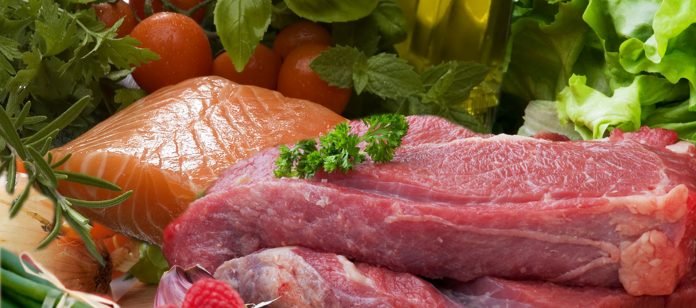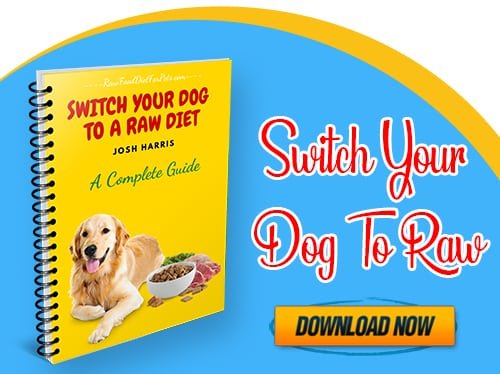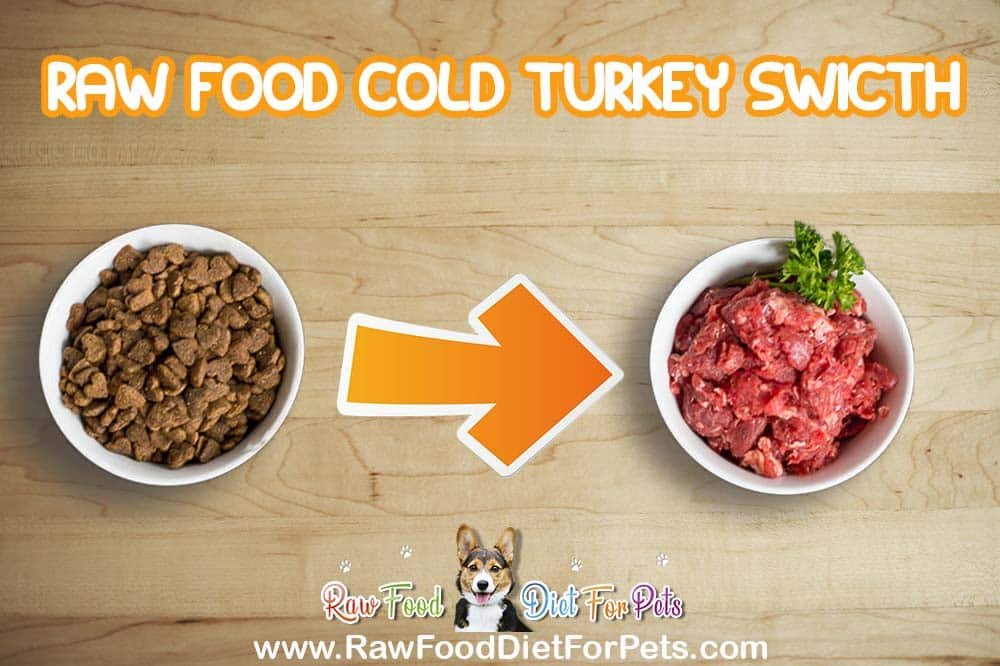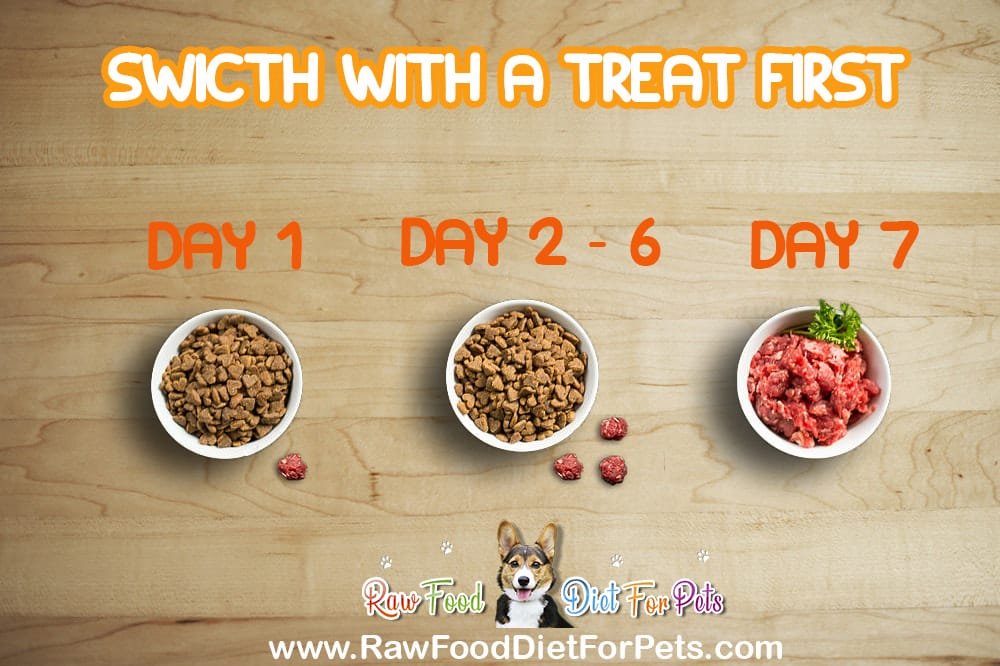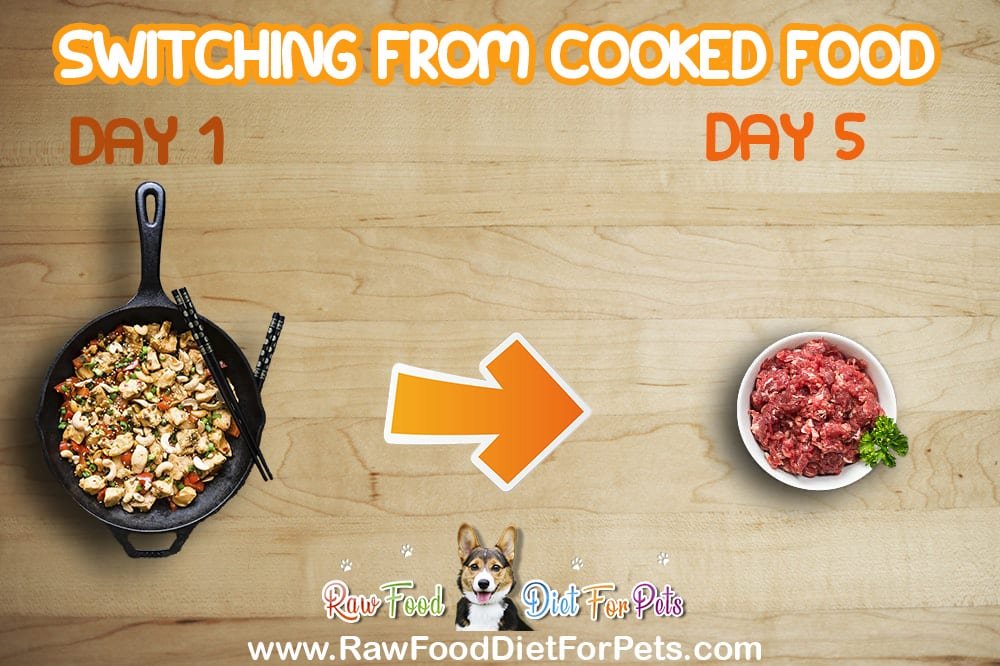So you want to transition your dog to a raw food diet but you’re a bit nervous. There is so much information out there presenting several different and in many cases opposing theories and instructions regarding making the switch.
It can be so confusing!
Don’t despair though…
If you stick with me, I’ll clear everything up for you. In fact, go grab your coffee and let’s get started!
Firstly, there are several transition methods. The method you choose should be the one that suits your schedule, lifestyle, and comfort level. It’s not a “one size fits all” approach.
In this article, we will break down the various transition options, the pros and cons of each and how to do each step-by-step. We will discuss everything you need to know so you can determine the option which is best for you and your dog; and we will do so step-by-step.
Quick Selection
Below we have a quick selection of the process you can use to switch your dog depending on your circumstances. Once you choose a method, you can then read about the process further below:
Puppies
Your dog is a young, healthy puppy – Use the immediate switch
Your dog regularly experiences digestive issues – Use the gradual switch
Mid Age Dogs
Your dog is healthy and is not used to raw food – Use the gradual switch
Your dog regularly experiences digestive issues – Use the gradual switch
Senior Dogs
Your dog is senior is not used to raw food – Use the gradual switch
You’ve Always Fed Your Dog Cooked Food – Use the combined switch
Your Dog Is Not Interested In Raw Food – Use the combined switch
Alright, now that you have chosen the right method for your situation, let’s get into it…
We have also created an eBook with the information presented in this article. If you are interested in having an eBook format instead, you can get the eBook here or click on the image below:
1. The Immediate (Cold Turkey) Switch
Some dog owners believe in transitioning their dog to raw food immediately. This normally happens once they hear of the benefits of raw food and negative effects of regular food on their dog’s metabolism. They quickly throw out all the processed food, run to the store, stack up on prepackaged raw food and never look back. They switch A.S.A.P!
Is that a good approach?
Well..
Many Dogs Get Sick After An Immediate Switch
Now, is this a good approach? In general, we would say no. Here’s why:
While we understand your eagerness to switch your dog from unhealthy processed foods, its important understand how your dog’s body works.
Remember now, your dog has been eating processed food for a long time. It is artificial, grain-based foods that your pet has been consuming all its life. The chemical makeup of these artificial, processed foods are very different from real, fresh, raw foods, so the digestive process is very different.
Furthermore, most dogs on processed foods suffer from:
• A serious lack of good, strong bacteria in the gut.
• An overall weakened digestive enzymes
• An overall weakened immune system
Because the dog’s body has been accustomed to digesting processed food, a cold turkey switch to raw foods may be more than your dog can handle. Not all dogs are fit for a quick and immediate transition. Issues that may occur as a result include diarrhea, digestive distress, and GI upset.
In fact, this kind of switch is often the reason dog owners and even vets blame raw foods when their dog gets sick after switching. In many of these cases, the problem is not raw food, the problem is that the switch was too immediate and so the dog’s body wasn’t able to adjust fast enough.
Which Dogs Are Likely To Have Problems Due To The Immediate Switch?
As we have already mentioned a cold turkey switch to raw food can have a distressful impact on your dog’s digestive system. As such, dogs with GI issues or any kind of stomach issues should not be put under an immediate switch to raw food.
Some Dogs Can Do Fine With An Immediate Switch
Having said all of the above, it is also true that many dogs do just fine with an immediate switch because some dogs have a stronger digestive system that can handle it, or their digestive system is not yet accustomed to processed food (this is true for young dogs ad puppies).
Will Puppies Have Issues With An Immediate Switch?
Young dogs and puppies have digestive systems that have not yet grown accustomed to processed food, so making the switch does not cause the kind of shock and digestive distress that it would cause for an older dog with a developed digestive system accustomed to processed food.
What if My Dog Refuses?
Some digs will simply refuse the immediate switch to raw food, especially if they have only had processed food all their life. In such a case, you will need to try one of the other approaches outlined below.
Pros
• Your dog will receive the benefits of raw foods immediately
Cons
• Digestive issues may occur with some dogs
• Some dogs will refuse the immediate switch
Best Suited for:
• Puppies
• Young dogs
2. The Gradual Switch
This is the opposite of the immediate switch. With this process, instead of switching immediately, you transition your dog to raw food gradually.

So what do we mean by gradual? How long will it take?
Well, that depends. It depends on your dog and your circumstances. For most dogs, the switch will last just about one or two weeks. However for other dogs, it can last up to 4 weeks or even 6 months because some dogs have very sensitive GI tracts that can become irritated very easily.
By slowly introducing new foods, you will decrease the risk of upsetting your dog’s GI tract. Moreover, slowly switching to raw foods will help you to gauge your dog’s preferences for certain raw foods as well as discover whether any intolerances exist.
There are four main plans for the gradual switch:
1. Raw treat first switch
2. Combined switch
3. Separate meals switch
4. Cook before raw switch
3. Raw Treat First Switch
The raw treat first approach is for persons who want to eventually switch to a raw diet but want to test their dog with a few raw snacks first. This way, you can easily test the waters and see how your dog reacts to small amounts of raw food.
We consider this a good approach for dogs with sensitive GI tracts because if your dog has some kind of intolerance to raw food or if any kind of adverse effect occurs, then you will quickly realize it and it won’t be extreme since a snack is a small amount of raw food. You can then adjust accordingly.
Instructions:
• Day 1: Get a tasty raw dog food treat such as lamb bone or duck neck. When you do this, you should be keen to keep an eye on the condition of your dog’s stool.
• Day 2 – 4: If the stool looks OK and your dog doesn’t seem to be facing any distress, increase the number of raw food treats you give your dog over the next several days. Of course, you should continue to monitor the dog’s stools.
• Day 5: If the stool remains normal, you can replace most of your dog’s regular processed meal with raw food.
• Day 5 – 7: Feed your dog these meals for several more days. If the stools remain normal and there is no distress, you can then continue with raw food permanently.
Pros
It’s a good way to test the waters
Great for avoiding stomach upset
Cons
The potential for stomach-upset stills exists because you will be moving from treats to raw in a short period of time.
Best Suited For:
• Dogs with sensitive GI tracts
• Young dogs
• Puppies
4. The “Combined” Switch
With this combined or mixed approach, you will offer your dog both types of food at the same time. Every time you feed your dog, you will offer less processed food and more raw food so you are esentially gradually swithcing out the processed food and gradually switching in raw food in a combined manner.
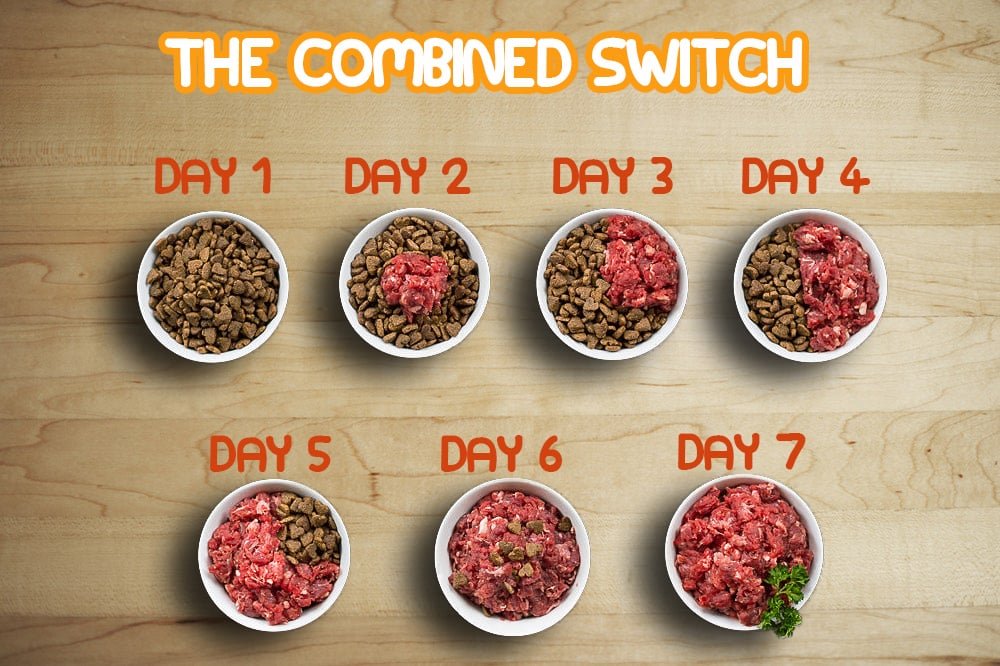
We consider this a good approach because combining both foods will allow your dog’s digestive system to wean itself of processed food while gruadually building up the ability to properly digest raw foods.
Consider the following as a starting point:
We are going to gradually switch your dog to raw food over a week or so:
• Day 1: feed 1/8th of raw food, 7/8th of the old food
• Day 2: feed 1/4th of raw food, 3/4th of the old food
• Day 3: feed 1/2 of raw food, 1/2 of the old food
• Day 4: feed 3/4th of raw food, 1/4th of the old food
• Day 5: feed 7/8th of raw food, 1/8th of the old food
• Day 6: feed 100% of natural raw food
For many dog owners, starting with a larger dose of say 1/4 raw food and 3/4 old food is simpler and easier. However, if your dog is hyper sensitive or has GI issues, start at 1/8th or even less if you wish. Also, please feel free to extend the transition time to two weeks or longer if you wish. As long as you feel it will make it easier on your dog and your family, we are ok with it.
Pros:
Great for avoiding stomach upset
Works well for dogs that refuse raw food after an immediate switch
Cons
Requires measuring food which may be inconvenient
Best Suited for:
• All dogs
• Older Dogs
• Dogs with sensitive digestive systems
Is Mixing Raw and Processed Food Unhealthy For My Dog?
You’ve probably heard this somewhere ‘mixing raw and processed food is unhealthy and can lead to digestive problems’
Let’s state first of all that any kind of sudden or even sometimes gradual diet change can cause digestive upset. It is the change that causes the upset, not the raw food itself. If your dog lived it’s whole life on raw food and you decide to switch to include processed food in its diet, then that would possibly cause digestive issues as well.
Now that we got that out the way, let’s now look at this a bit deeper
So the claim is that raw food digests within just a few hours while processed and cooked food take much longer, between 12-24 hours to digest. They then say that this difference between the rates of digestion causes GI irritation which leads to GI upset.
Sound reasonable right?
Well not quite.
Let’s discuss:
Firstly, many people mix fresh raw food with processed and cooked food with no issues. In fact, there is academic proof in support. This study discusses a decrease in the risk of canine cancer as a result of adding fresh, raw foods to processed diets.
Additionally, Finnish veterinarian, Dr. Anna Bjorkman conducted a study into the effects of raw food diets which revealed that a dog’s diet has the ability to reduce the odds of disease when 20% (1/5th) is raw.
See her discuss it in this video.
So here are the real, hard facts:
1. Processed foods actually digest faster than fresh, raw food (see the data here). That makes sense. What moves out of you quicker? Low quality foods or healthy foods?
2. While raw food and processed food are digested differently, you shouldn’t be worried about the timing, instead the real issue is the difference in how they are broken down. We explain below.
The Real Issue With Mixing Raw and Processed/Cooked Food
In this article, Veterinarian, Dr. Karen Becker explains that most raw food (especially meat) is broken down to protein in the gut. On the other hand, most processed and cooked food is broken down to starch.
When this mixture is encountered in the gut, digestive confusion can sometimes occur. This confusion then may causes gassiness and belching. This is especially true for dogs with digestive issues. However, for most dogs, there very little to simply no issue at all.
5. The “Cooked” Switch
Many dog owners don’t feed their dogs processeed food, but cooked food instead. If you have always fed your dog cooked food and wish transition to raw food, then this is probaly the best option for you.
This option is especially beneficial if your dog is sick or does not care for raw food as it allows more time for their stomach to build up the ability to properly process raw food.
Instructions:
Here’s how you can go about making the switch from cooked food over just 5 days:
• Day 1: cook the food about 80% of the way
• Day 2: cook the food ¾ of the way
• Day 3: cook the food ½ of the way
• Day 4: cook the food ¼ of the way
• Day 5: serve the food in a raw state
Pros
A good option for sick dogs
Prevents digestive upset
Cons:
Meals require more time to prepare
Best Suited for:
• Dogs used to eating cooked meals
• Picky dogs
• Ill dogs
Best Suited for:
• Senior dogs
• Dogs used to eating cooked food
• Picky dogs
• Dogs with chronic illness
• Dogs with an impaired immune system
So there you have it, the best methods to go about switching your dog from old processed foods to natural, raw food. Remember, the most important thing when switching is to pay close attention to how your dog is handling the process.
General Tips For Switching Your Dog To Raw Food
• How fast you transition from processed or cooked to raw food depends on how your dog is handling it. Remember all dogs are different and so in many cases, you will need to extend the transition schedule.
• If your dog is experiencing any sort of digestive issues with raw food, wait until the issues are resolves before moving to the next stage of the process.
• If you are going to cook meat, it’s important that you remember to offer cooked meats only. In no case should you ever offer your dog cooked bone. Cooked bone is prone to splintering and should not be fed to dogs as it may damage the stomach.
What Stage In life Is Your Dog?
It’s important to realize that the approach you decide to use depends in part on the stage of life that your dog is at. Let’s look at some special considerations to keep in mind depending on your dog’s stage in life:
Puppies:
Puppies are young and as such tend to have a healthier digestive system. This is why puppies can tolerate a rapid switch in diet. In fact, many puppies can handle a raw transition in as little as 1 or 2 days with little to no issue. This is why puppies can be transitioned with any method mentioned above, including the quick cold turkey switch.
Middle Age Dogs:
Dogs during their mid-ages or the prime stage of their life are normally healthy and have relatively healthy digestive systems.
They are not able to transition as fast as puppies, but they normally transition faster than older dogs with more stubborn digestive systems.
Senior Dogs:
Older dogs that have been living on processed/cooked foods all their lives have digestive systems that are conditioned to these types of foods. In many cases, their digestive systems have become fragile and easily susceptible to shock if sudden dietary changes occur.
As such, older dogs normally need plenty of time to gradually switch to raw food. Take your time and allow your dog to make the switch without any issue. Whether the process lasts a few weeks or even months, be patient and don’t rush it.
Conclusion
That’s it, the complete guide on swicthing your dog to raw food. We hope you found a method that suits your preferences and lifestyle. Whenever you are ready to begin, just remember we are here with you. We have several articles related to switching and maintaining a raw diet. Feel free to browse our site rawfooddietforpets.com and sign up to our newsletter where we share raw food tips and tricks on a regular basis.
















